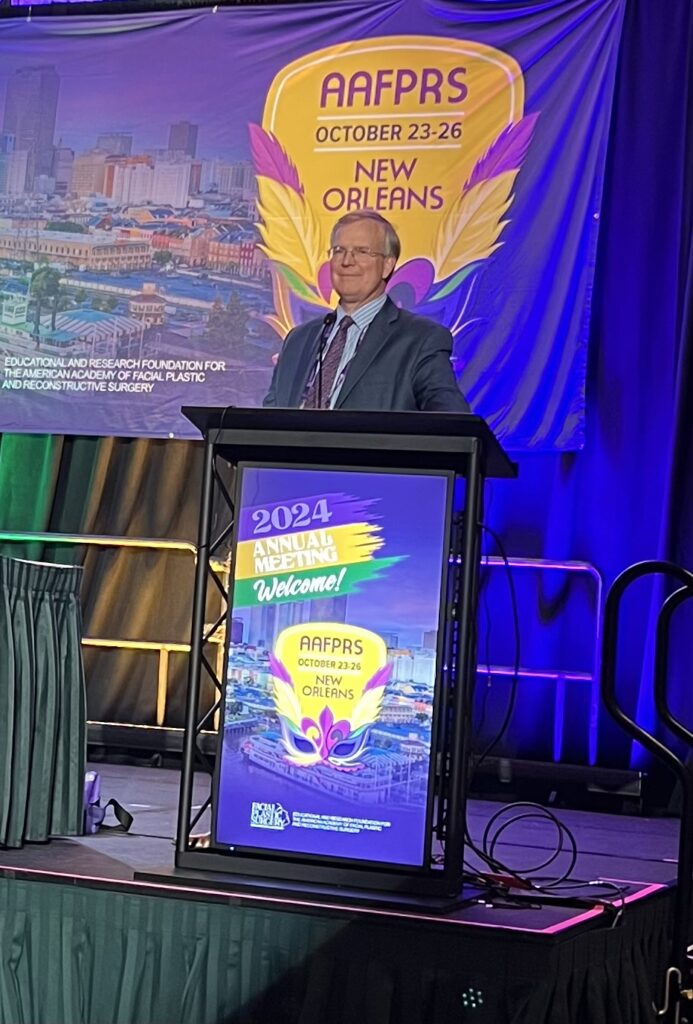Dr. Brannon Claytor Presented Facelift Techniques at 2024 Facial Plastic Surgery Annual Meeting
Philadelphia, PA—Double board-certified plastic surgeon Dr. R. Brannon Claytor of Claytor Noone Plastic Surgery presented his facelift techniques at the American Academy of Facial Plastic and Reconstructive Surgery (AAFPRS) 2024 Annual Meeting, which took place from October 23 to October 26, 2024 at the Hilton New Orleans Riverside in New Orleans, Louisiana.
The Philadelphia plastic surgeon led educational sessions for fellow plastic surgeons on the benefits of performing deep plane facelifts under local anesthesia, as well as on the hemostatic net lift using clear, absorbable sutures.

“Facial rejuvenation has seen remarkable innovation in recent years, and it is an honor to share my advanced facelift techniques with fellow surgeons at the AAFPRS meeting,” said Dr. Claytor. “When we come together as surgeons to share knowledge and fine-tune our approaches, what matters most is that patients benefit from better results, minimized complications, and streamlined recovery processes.”
The AAFPRS is the world’s largest specialty association for facial plastic surgery, representing more than 2,200 facial plastic and reconstructive surgeons worldwide. The organization’s annual meeting is the foremost event for these surgeons. It serves as a platform for education, innovation, and collaboration, featuring comprehensive educational programs, workshops, research presentations, and networking opportunities for the physicians who are shaping the future of facial plastic surgery.
Dr. Claytor’s first presentation, titled “Deep Plane Facelift Under Tumescence,” shared the many benefits of performing his signature deep plane facelift technique while patients remain awake, with tumescent anesthesia that numbs the surgical area and an oral sedative medication that supports relaxation. While facelifts are traditionally performed under general anesthesia, the facelift surgeon has found that both surgeon and patient benefit from this local anesthesia approach.
“My patients appreciate avoiding general anesthesia for facelifts because they simply feel better after surgery,” said Dr. Claytor. “Without the residual grogginess, my patients are able to get back to their routine at home, including preparing meals for themselves, within 24-48 hours of the surgery.”
Other benefits of local anesthesia include less postoperative nausea and a reduced risk of complications that can result from general anesthesia. Both facilitate a smoother and quicker recovery. At the AAFPRS meeting, Dr. Claytor shared his protocols for patient selection, anesthesia administration, and surgical techniques to empower other surgeons to adopt this patient-friendly approach without compromising results or safety.
“I perform deep plane facelifts under local anesthesia in my onsite, Quad-A accredited surgery center, which gives patients extra peace of mind and allows them to avoid the busy hospital setting,” Dr. Claytor commented. “Between the privacy and the ability to get back on their feet sooner, I find that patients who undergo this type of facelift are especially happy with the entire experience.”
Dr. Claytor’s second presentation, titled “Clear Absorbable Hemostatic Net,” detailed his unique approach to the hemostatic net lift—a facelift technique using sutures in a “netting” pattern that act as a supportive matrix for the skin. The hemostatic netting technique (also known as Auersvald technique) is meant to reduce the incidence of hematomas, in which blood collects under the skin after surgery, while also reducing the need for post-surgical drains. It may be especially helpful for patients at higher risk of hematoma, such as those with high blood pressure.
“While not widely adopted, the hemostatic net has received increased attention online in recent years, due to the visibility of sutures outside the skin,” said Dr. Claytor. “As more patients request information about it, it is important to me to share my approach and experiences with the hemostatic net, educating fellow surgeons and sharing protocols.”
While this technique has predominantly incorporated dark, non-absorbable sutures, which must be removed several days after surgery, Dr. Claytor’s presentation detailed his experience creating the hemostatic net with clear, absorbable sutures. He demonstrated its application through case studies from his Philadelphia practice and discussed best practices for integrating it into surgical routines.
With over 20 years of experience, Dr. R. Brannon Claytor is a double board-certified plastic surgeon and the Chief of Plastic Surgery at Main Line Health. He is a Board Member of The Aesthetic Society, an 8x Top Doctor Winner in Philadelphia Magazine, and one of Newsweek’s America’s Best Plastic Surgeons. In addition to presenting his research globally, Dr. Claytor’s research has been published in leading medical journals, with a 2023 paper winning “Best Paper” by Plastic and Reconstructive Surgery, the official journal of the American Society of Plastic Surgeons (ASPS). His practice, Claytor Noone Plastic Surgery, is located in Bryn Mawr, PA, and serves the greater Philadelphia area with a comprehensive range of surgical and non-surgical procedures, including facial rejuvenation, body contouring, breast surgery, and medical spa treatments.
“The ultimate motivator for me is helping patients look and feel their best,” said Dr. Claytor. “Staying at the forefront of surgical innovation is a key tenet of my patient-first philosophy, as it helps us all achieve the best possible outcomes.”
